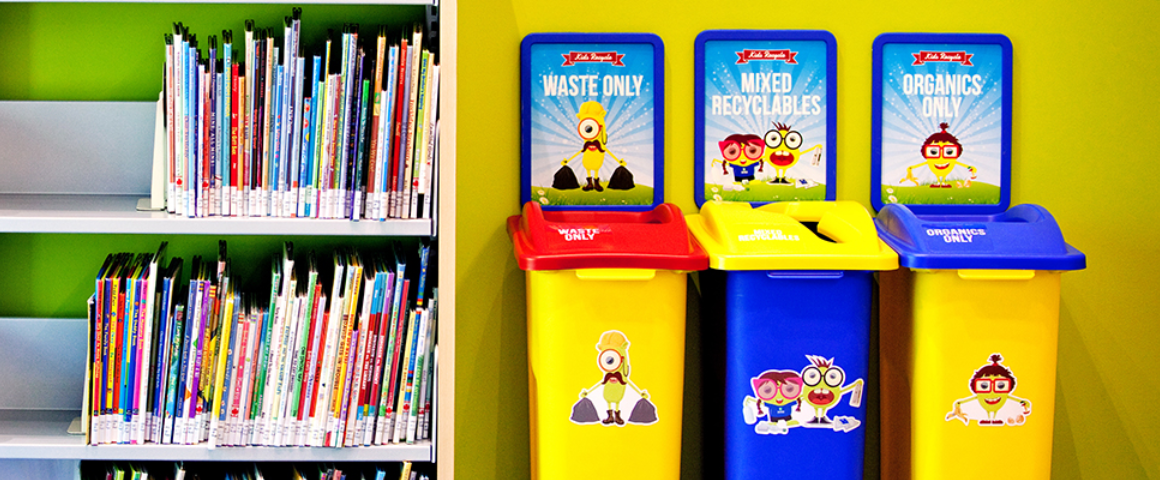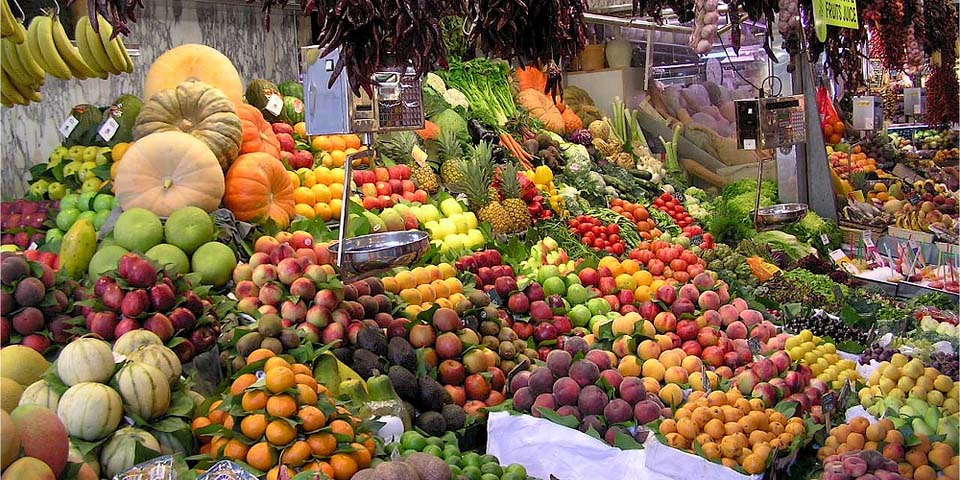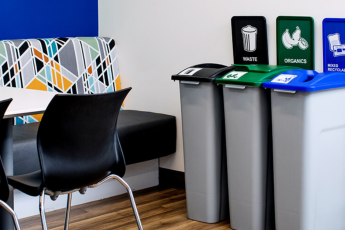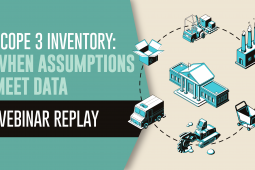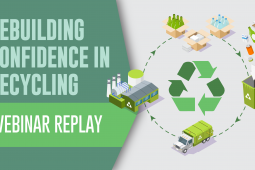For more information on how to build an exceptional recycling program for your elementary or secondary school, click here.
We’ve been building exceptional public & private school waste management programs for over 35 years. Here’s 9 key tips that’ll build the zero-waste program you’ve always wanted – and save you money in the process!
Elementary & Secondary Schools are massive producers of waste, most of which is easily recycled with the correct program in place. By running an effective school recycling program, you can help ensure that landfill-destined trash is greatly reduced, and that recyclable items are turned into new products!
Let’s start with the facts:
- The average secondary school produces 22kg of waste per student each academic year. The figure for primary schools is even higher at 45kg per student.
- At least 40 percent of a typical school waste stream is paper.
- Glass and plastic beverage containers account for about 15 percent of a school’s waste stream (and recycling just one glass bottle saves enough energy to power a 100-watt electric light bulb for four hours!).
- According to Regional Recycling, your school district could see as much as $70,000 added to its operating budget from a beverage container recycling program.
When a school has an effective recycling program in place, it sets a standard for the community, and produces more eco-conscious future-leaders.
An effective program focuses on reducing waste, reusing useful materials, and recycling as much as possible. Ineffective school programs tend to generate a lot of waste, require regular maintenance, and result in expensive waste disposal. Bearing these things in mind, let’s take a look at 9 key ways to enhance the effectiveness of your elementary & secondary school recycling program:
- Do some background research.
Check to see if there were any past recycling efforts at the school. Find out what worked, and identify any obstacles that may have kept the program from running smoothly in the past.
Familiarize yourself with Waste and Recycling laws in your area to make sure your future program is within legal boundaries. Look into what kinds of waste is being produced by the school, and check to see what waste streams are collected by local waste management companies. Check the frequency of pickup and the cost of diverting waste to make sure you have all the data you need to build an effective plan.
Additionally, check for any local, state/province, or country-wide grants that might be available and often assist in alleviating the costs of implementing a sustainability program. If you are located in the US, we have complied a list of some grants and other state & federal funding opportunities that may be available to you!
Once you’ve gone through this research process and have all the data you need, you’ll be ready to get started!
- Always begin with a waste audit to categorize and quantify your school waste
Step one of building a successful waste management program for your school begins with identifying and categorizing the types and quantity of waste produced by every segment of your facility grounds. Use a map of your grounds to identify key areas (i.e parking lots, recreational facilities, cafeterias, classrooms, hallways, schoolyards etc.) and begin to identify what types of waste is being generated in each area.
Once you have an idea of the current waste generated at your school, you’ll be able to plan accordingly for it, and analyze where there are opportunities for waste reduction & diversion.
Review the school’s waste record for the past 12 months to determine:
- How much waste was produced?
- How often is the waste collected/hauled away?
- What happens to the waste after it leaves the school (where do the haulers take it)?
- What has been done so far to reduce, reuse, and recycle waste?
- Build a Green Team
How much time do your janitorial staff and teachers have to spare for sustainability initiatives?
If the answer is less than you would like, a green team can be the most valuable ally in your quest for building an effective recycling program.
Many schools simply lack that “passionate advocate” to get recycling started in the school. Recycling success depends on a group of dedicated individuals to plan, develop, and implement the program. A school recycling advocate can be a teacher, student, administrator, or parent. Passion for recycling can spread quickly, resulting in recycling becoming an efficient and normal part of the school routine – but the spark to get the school to begin recycling is essential!
A Green Team can be a small group of employees or community volunteers whose combined goal is to educate, empower, and inspire fellow staff and students to establish and promote environmentally sustainable practices within their organization. Every new initiative needs a full launch campaign and a group of “influencers” (example-setters) that will help build the momentum of your program. Without a team working with you, it will be very difficult to get your new waste management program off the ground all by yourself.
To set up your green champions for long term success, make sure this group has formal oversight, tools for measurement and verification, and a clear mission!
- Communicate your program to your students and staff
Make sure students and staff know and have been taught about your recycling initiatives. And remember – this can be the fun part! There are so many great resources, books, and tools to get students excited, educated, and aware of why recycling and sustainability is crucial to the sustainability of our plant.
EcoSchools Canada is a really great resource to reference in regards to building recycling engagement with students. Their mission is to “nurture environmental leaders, reduce the ecological impact of schools, and build sustainable school communities”. EcoSchools Canada helps:
- Certify K-12 schools in environmental learning and action
- Create a vibrant network of schools, school boards, and community partners
- Build strong EcoTeams with training sessions and tools
- Embed ecological literacy into the curriculum and daily practices
While their focus is obviously geared towards schools in Canada, we would suggest learning more about their modern program, as they’re taking a new, progressive approach to recycling in schools!
For continued education, create easy-to-understand signs for your recycling & waste stations. Including pictures on signs of what items belong in each bin (or even attaching the actual items to signs) is a great way to clarify what’s recyclable, compostable, or destined for landfill. This is especially useful for students who are just starting to learn to read! PSAs or other in-class announcements about recycling, posters, and contests can all help involve students and make sure they’re disposing of materials correctly. Reach out to students during recess and other events with special recycling collection (volunteers can help here), and consider including education about your initiative on your website and in social media so that parents can get involved as well!
- Modify your operational habits
The daily operation of your school provides you with an excellent testing ground for waste management techniques.
Reducing the amount of waste your school produces begins with modifying little things. Here’s some examples to get your creative juices flowing:
- Use biodegradable/compostable food containers for serving in the cafeteria, or switch to entirely reusable cutlery & serving plates that can be washed and used over and over.
- Encourage students to bring their lunch from home in reusable containers.
- Instead of selling bottled water, install water fountains throughout your school. You can even find a local partner that is interested in donating/supplying reusable cups, mugs, water bottles, etc. for staff and/or students to use while in school.
- Use high-traffic areas to promote your recycling goals by adding large, attractive recycling stations with signage to promote your messaging.
- Avoid paper products other than toilet paper in the bathrooms.
- Keep a scrap paper box in every classroom to encourage reuse of large paper scraps, and/or printing on blank sides of previously-used paper.
- Hold recycling contests between classrooms or grades to see who can collect the most recyclable materials in a month, have the lowest contamination rates, come up with new ideas to promote reduce/reuse/recycle/re-earth, etc.
- Set all printers to default to double-sided printing, and encourage digital communications & school products to reduce paper usage (eg. collect student assignments and distribute staff documents online rather than printing them out).
- Start a beverage container recycling program
Many facilities across industries have specific items that play a significant role in their recycling program. For schools, those items are paper, cans, & bottles. Bottles are the perfect focal item for a school due to their value to local MRF facilities and bottle depots. Jump on Google and start researching available organizations to partner with that will pay you to pick up & recycle your cans & bottles! As previously mentioned, your school district could see as much as $70,000 (!!) added to its operating budget from a beverage container recycling program.
- Tackle single-use plastics and organics
Many schools are implementing single-use plastics bans at their schools, which is a wonderful step to reducing the amount of plastic entering school grounds. As an example, Ursuline Secondary School in Blackrock, Ireland is looking to phase out single-use plastics by removing all single-use plastic water bottles. All students have been issued reusable stainless steel bottles instead, which the school estimates will reduce the use of approx 500 plastic water bottles every month!
Composting isn’t available in every community, but working with your haulers (or seeking additional help) to get organic discards collected for composting (including landscaping and food waste) can make a big difference. Another option is to purchase compostable food serviceware. Buying biobased, compostable serviceware (made from plant-based plastics, ideally waste-based, and certified compostable by ASTM) means that your food service items can be composted instead of trashed, if composting is available in your school, and helps move the serviceware market away from reliance on non-renewable materials like fossil fuel-derived plastic. For more information about organic waste mandates and/or starting a food waste program, you can check out our blog post: Food for Thought: A Breakdown of Organic Waste Programs & Regulations.
- Re-evaluate Disposal Habits
Not long ago, waste removal was mostly built around collecting co-mingled materials and sending the waste to landfills, where it was incinerated or compacted by waste disposal companies. These days, however, your green team and janitorial staff can take an active role in managing part of the process.
Food waste is one of the largest waste streams on school grounds, and fortunately there’s a new crop of haulers that focus solely on organics/compost collection that will gladly collect your food waste, often at reduced costs. And if that’s not an option, you can always invest in food composters to reduce the binned waste generated by food leftovers during lunch periods. Or, start a small on-site composting program where your school’s food scraps help fertilize the outdoor grounds, or even a community or school garden (classes or grades can use the garden as a learning tool and/or project from year to year, and any food grown from it can be used in your cafeteria).
- Choose the right recycling stations and place them appropriately
There’s a hodgepodge of factors you need to consider when purchasing containers to suit each space around your school–too many to cover in this blog! However, as a start, if you want your school recycling & waste program to be successful, it’s imperative that you choose containers that keep all of the collection streams grouped together in central locations, regardless of the location of those stations across your school grounds.
For example, if there isn’t a recycling or compost stream directly next to the trash stream, students and staff will just end up tossing all their waste in the most convenient bin—the closest one. This leads to enormous amounts of contamination, which can derail your sustainability goals due to your recycling and compost often ending up in the landfill rather than being properly sorted upon disposal.
Quickly, some other things to consider when choose the right recycling & waste station for your school are:
- Placement (where are they most easily accessed and visible to encourage use?)
- Climate (what weather/climate factors do you need to consider or prepare for to ensure the durability of your bins?)
- Capacity (one size does not fit all – what works in a classroom won’t necessarily work in hallways or cafeterias)
- Restrictive Openings (openings that are the shape of the material you’re looking to collect – round, small openings for cans & bottles, long, narrow slots for paper, etc – will decrease contamination rates)
- Signage & Label Customization Capabilities (eg. for younger students, bold and colorful bins are a fantastic way to get them exciting about recycling, and using pictures/visuals as well as words can help those learning how to read properly sort their waste)
- Stations not Containers (as we mentioned, trash cans should never feel lonely – a recycling bin makes a great companion!)
Make sure you’ve located well-marked, easy-to-use waste containers throughout your school – and make sure every time there’s a waste bin, there’s a recycling bin next to it. Some schools have taken this strategy even further by creating zero-waste stations with fewer waste receptacles, instead offering more containers for recycling and compost collection. Place bins wherever you think students and staff are likely to need them – near cafeterias, near entrances & exits, etc. – and, optimally, place stations so that at least one is always in view (e.g., every 25 feet).
Start your public or private school waste management program off on the right foot by taking advantage of these 9 industry tips! And remember, once you’ve launched your school waste management program, you’ll start to see more areas for improvement. These minor or major improvements will continue to increase your diversion rate and positive impact on the environment, reduce your costs and ultimately enhance the sense of togetherness with your community.
Need help getting started? Contact us to chat with our School Waste Management Specialists for more direction on where to begin your journey to waste management greatness.
